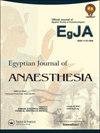Analgesic efficacy and functional outcome in refractory cases of plantar fasciitis treated with platelet-rich plasma: randomized comparative study with corticosteroids injection
IF 0.5
Q3 ANESTHESIOLOGY
引用次数: 0
Abstract
ABSTRACT Background Steroid injection is a widespread treatment for plantar fasciitis but seems to be useful to a lesser extent, Platelet-rich Plasma (PRP) injections into the plantar fascia start the healing process required to stop the degeneration of the plantar fascia at its root. Aim of the study To compare analgesic efficacy, functional outcome, degree of satisfaction and improvement of fascial thickness and echogenicity after platelet-rich plasma injection versus corticosteroids injection in refractory cases of plantar fasciitis. Patients & method 60 patients with refractory plantar fasciitis who were resistant to conservative treatment were randomized to receive either PRP or steroid injection. All patients were assessed with the American Orthopaedic Foot and Ankle Society (AOFAS) score, Visual Analogue Score (VAS) for pain, the Roles-Maudsley (RM) Score and plantar fascia thickness and echogenicity. Data were collected prospectively, pre-treatment, at 3, 6, 12 week, and 6 months post-injection. Results There was significant improvement in both groups as regards the clinical outcome measures involving (VAS & AOFAS) and radiological outcome measures including (thickness and echogenicity) in all post-injection times. However, steroid group showed early improvement (at 3rd week post-injection) with short duration while PRP group showed improvement at 12 weeks post-injection till the end of the study. Conclusion The use of PRP injection is safer with better analgesia and functional outcome than steroid therapy for treating chronic plantar fasciitis.富含血小板血浆治疗顽固性足底筋膜炎的镇痛疗效和功能结果:皮质类固醇注射的随机比较研究
本文章由计算机程序翻译,如有差异,请以英文原文为准。
求助全文
约1分钟内获得全文
求助全文
来源期刊

Egyptian Journal of Anaesthesia
Medicine-Anesthesiology and Pain Medicine
CiteScore
0.90
自引率
0.00%
发文量
78
 求助内容:
求助内容: 应助结果提醒方式:
应助结果提醒方式:


